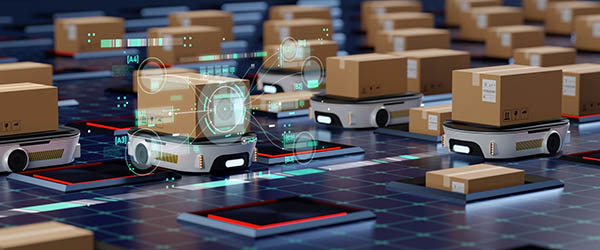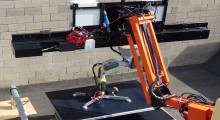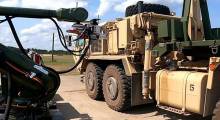Once the dreams of science fiction writers and blockbuster movies, robots have cemented themselves as key features in warehouses and manufacturing facilities. Something that fiction writers never seemed to consider when devising their robotic characters was how they would draw power. Perhaps in these stories — visions of a far-advanced future — concerns about circuitry and power distribution were a thing of the past. Unfortunately for today’s robotics, the logistics of powering and maintaining a robotic workforce remain a top concern.
As warehouses push the limits of technology to boost efficiency, the demand for specialized robots is rising — and that means demand for new ways to power next-generation workforces is growing alongside it.
With so many variations in each robot’s design, responsibilities, and capabilities, powering the next generation of coworkers has become a complex task. Fortunately, power engineers and designers are well-versed in building solutions to tomorrow’s challenges.
Here are three innovations that could change how we power industrial robots in the coming years:
Advancements in wireless charging
Debate about the merits of adopting widespread wireless charging has been raging for some time. Implementing wireless charging at scale has the potential to boost productivity by eliminating extended charging periods and reducing battery sizes. The technology also has the potential to improve safety conditions within potentially hazardous environments by eliminating exposed electrical contacts.
However, those benefits come at a price, and it’s steep. Retrofitting warehouses to support wireless charging across robotic workforces is a significant undertaking, as is designing new warehouses to accommodate this technology. Also of concern are the potential energy losses that often accompany wireless charging technologies. To date, these concerns have outweighed the efficiency and convenience that wireless charging solutions might offer.
Advancements in wireless charging, like close-coupling induction, now offer highly efficient power transfers without cables. With close-coupling induction, robots and charging stations do not need to be physically connected with cables, nor do they need to touch.
This method allows up to a quarter-inch of space between the robot and the charging station with around 90% efficiency, a significant increase from previous wireless methods. This saves operators time and money as it enables robots to charge while completing other functions or during natural downtime.
Furthermore, the flexibility of having more space between robots and chargers can simplify the task of warehouse design and help ensure robots receive an adequate charge every time. Advancements like resonant inductive coupling and the power topologies that they enable may soon make the benefits of widespread wireless charging more compelling.
Rethinking board-mounted power
Many robots today have onboard power topologies that use discrete components carefully selected to meet the needs of the build. While discrete designs ultimately get the job done, tasks like determining board layouts, testing and validation, and selecting magnetics all take valuable development hours. Perhaps more challenging is achieving power-dense layouts with discrete components, which is an increasingly important task.
Modular point-of-load (PoL) converters with high power densities provide a simpler alternative. These DC/DC converters leverage carefully curated components, semiconductors, and magnetic technologies to provide space-conscious configurations with high-power-density layouts. These modules are often tested and validated for compliance with stringent specifications, which helps robotic engineers to better use power to improve functionality and performance.
These power modules are constantly evolving. With the advent of semiconductor materials such as Silicon Carbide (SiC) and Gallium Nitride (GaN), even higher-powered solutions can be developed to support next-generation, high-voltage applications — including those in the kilovolt range.
Wide bandgap solutions like these also allow for a much thinner semiconductor product since junctions can handle voltages that are up to three times higher than Silicon. The high-electron-mobility quality of these semiconductors allows for higher switching frequencies, faster heat dissipation, and better thermal stability during operation. However, not all applications can benefit from SiC or GaN.
The ability to use integrated PoL converters and voltage regulators instead of discrete designs for power conversion can also help improve power density and decrease time to market. These designs offer complete, modular conversion solutions that can scale to meet a wide range of power needs without needing to fully replace the circuit board. We can expect such innovations to continue as industrial robot use increases and power demands continue to grow.
Intelligent facilities
Power is the primary currency in the world of robotics and automation. As warehouses grow and robots continue to take on more roles, managing power consumption is going to be crucial from both commercial and logistical standpoints. With more robots come more batteries to be charged and more motors to be energized. Both of these loads can draw a notable amount of power from the supply infrastructure.
In an intelligent facility, the energy management system communicates with the process automation platform to schedule robot charging and use motors more effectively, reducing power costs and better managing the load on the power infrastructure. In the absence of such a solution, operators with large robotic workforces run the risk of spiking power demand beyond the infrastructure’s capacity which can cause unwanted power interruptions.
Furthermore, intelligent scheduling helps improve productivity by ensuring the right number of robots are ready to work at any given time and limit the extra energy costs that can come along with unsteady demand.
While we’re still a way off from the seemingly self-charging, self-scheduling, perpetually at-the-ready robots of fiction, we’re getting closer by the day. Robotics engineers are making strides to improve the efficiency and functionality of robots every day, and they can rest assured that power engineers are doing the same.
Close-coupling induction, modular power conversion designs, next-generation materials, and intelligent power systems and facilities represent just a fraction of the innovations that may change the face of warehouse robotics in the coming years. In science, progress begets progress. As with all inventions, these technologies will form a basis for the next generation of power design and robotics technology — in warehouses and beyond — and set the stage for a more efficient and productive future.
About the author
 Gopa Mitra, industrial segment leader at ABB Power Conversion
Gopa Mitra, industrial segment leader at ABB Power ConversionGopal Mitra is the industrial segment leader at ABB Power Conversion, which designs, develops, and manufactures reliable, high-quality power solutions for mission-critical applications. He works closely with customers to understand and address their toughest power challenges in applications such as robotics, electric vehicle charging, and lasers.
Article topics
Email Sign Up

















